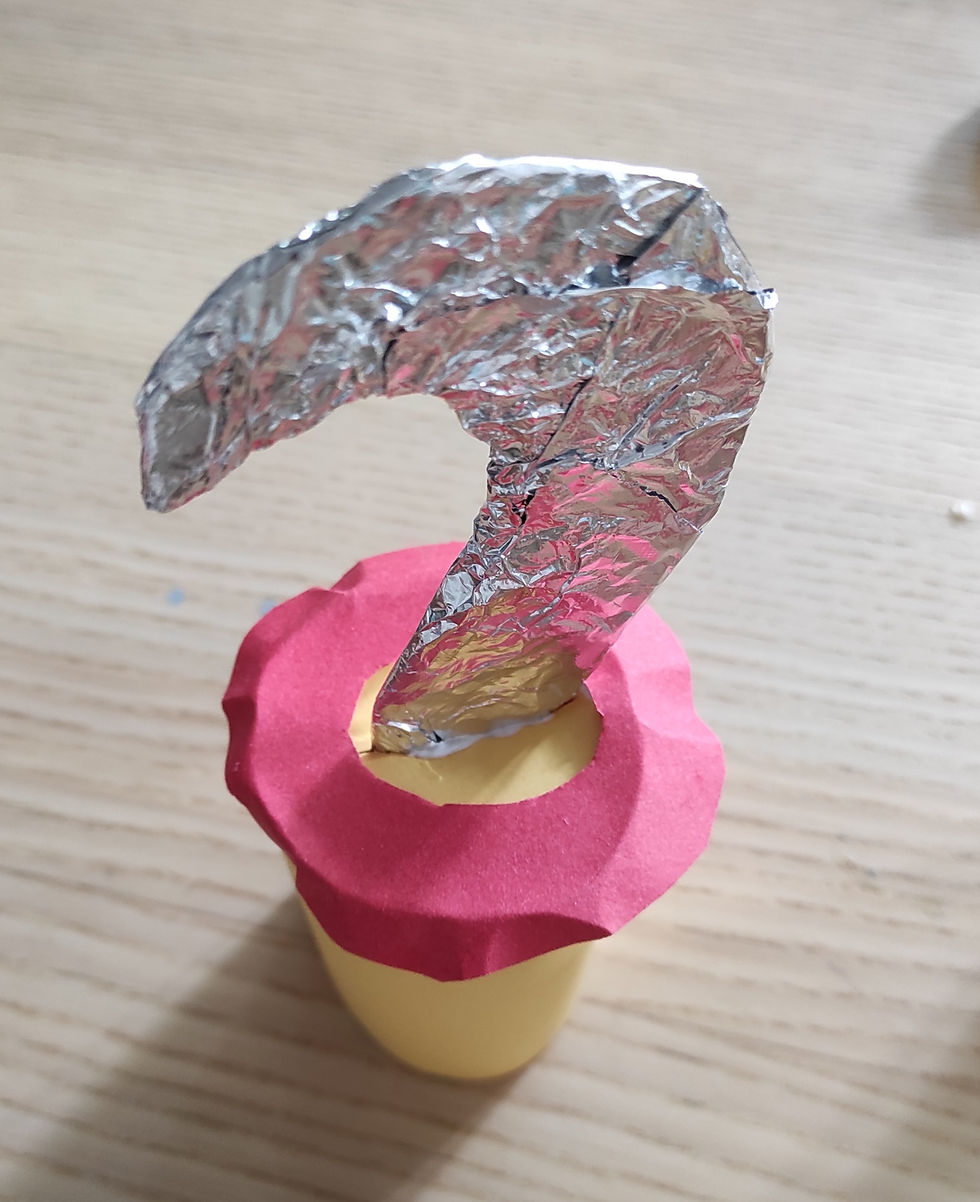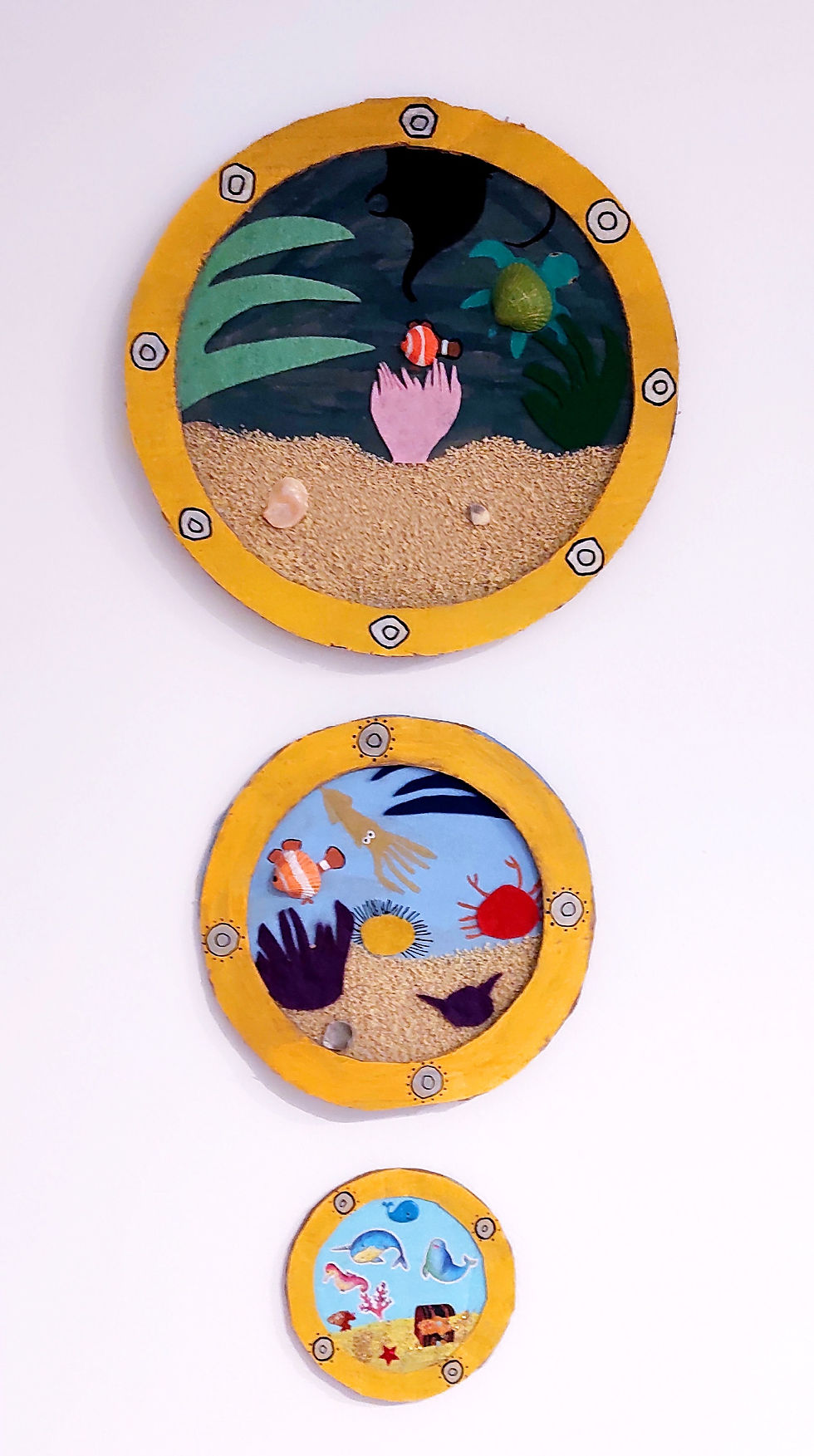Seas and oceans - their inhabitants and their pirates
- Orsucci Marion
- Aug 3, 2023
- 6 min read
Welcome to the world of the sea, a very classic theme that offers lots of creative opportunities.
On this page, you will find lots of DIY ideas to make with your children during the summer holidays (or even at other times of the year). DIY ideas are classified in four different categories: Creative activities, Small-Worlds, Coschooling and Other Activities.
Creative Activities
Boats
Departure by sea aboard various boats.
1. Nut boat
Details (materials and step-by-step): here
A quick activity that doesn't require a lot of materials (nuts or shells, glue or patafix, paper and a toothpick).
They can float if you balance them well and you can imagine to do a boat race by blowing into a straw to make them move forward.
2. Milkman's boat
Details (materials and step-by-step): here
An activity based on recycled cardboard (milk cartons, cardboard straws). This activity is quite long (several days) but very complete, involving gluing, cutting and painting.
3. Boat on water
Details (materials and step-by-step): here
An activity for developing graphic skills and learning shapes by drawing waves and sand and cutting/pasting geometric shapes.
Animals

- Hippocampus, the seahorse
Details (materials and step-by-step): here
An activity to recycle toilet rolls and create a rainbow seahorse.
- The tentacle dance of Miss Jellyfish

Details (materials and step-by-step): here
Cutting/Pasting activity.
This jellyfish can be placed outside or in front of a window to let its tentacles dance.
- The giant Octopus

Details (materials and step-by-step): here
Learn to draw straight lines, cut, fold and glue papers. This activity is perfect for developing children's fine motor skills.
By making several tentacles and alternating colours, children will have to follow a logical sequence.
A complete activity that will decorate an entire wall.
- Between coral and anemone

Details (materials and step-by-step): here
Animals can take many different forms. Here are two DIY ideas to help you talk about corals with kids, or even just to enrich a small sea world so that they can play freely with different marine organisms (here).
- The sticky fish

Details (materials and step-by-step): here
Recycling toilet rolls and patchwork collage.
- Rolled octopus

Details (materials and step-by-step): here
Recycle toilet paper rolls by cutting and painting them.
- Rainbow fish

Details (materials and step-by-step): here
Perfect activity to make with little ones. Playmais are very attractive to young kids (colour, texture, etc.) and they'll love sticking them by using water. It's an activity that's quick to set up and doesn't require extreme vigilance on the part of the adult when the child is making it.
- The Protective Fish
Details (materials and step-by-step): here
Croc-croc, be careful not to bite if you try to catch the baby fish.
A simple activity that requires very little equipment and gets children playing while exercising their fingers (perfect for developing fine motor skills).

- Finger fish
Details (materials and step-by-step): here
Children love to use their hands or feet as a model to draw. Fish fit perfectly well to this exercise.
- Fish in your ears

Details (materials and step-by-step): here
This is an activity for older children (> 7 years old) as it requires a lot of patience and attention to detail (the fish are small). For younger children, this activity can be carried out on a larger fish model (e.g. for a key ring).
Modelling the polymer clay and assembling the scales is not an easy task.

The Turtle family
Made from shells and thick paper, these turtles will be a lovely memory of your sea holidays.
Details (materials and step-by-step): here
- Sun-catcher Turtle

Details (materials and step-by-step): here
A nice light in your window by making a sun catcher in the shape of a turtle. The body is made of cardboard and the shell is made of plastic, a way for me to discuss recycling, pollution and ecology with the kids.

- Shell of shells
Details (materials and step-by-step): here
Made from clay and shells. A beautiful turtle's shell that brings together some of the treasures of nature collected by the children during the holidays.
- Little Crab

Details (materials and step-by-step): here
A fun way to use the shells that the children have collected on the beach.

- Course de crabe
Details (materials and step-by-step): here
Same technique as for making the crab above, but this time they will be able to move.
By rolling the cotton string, the crab moves towards the child. The first crab to cross the line wins the race.
Pirats
- A pirat in your hand
Details (materials and step-by-step): here
Did you know that you can imagine and draw lots of different characters with just one hand?
You can turn your hand into a real pirate. It's a complete activity with a wide range of techniques: tracing, cutting, painting and gluing.
- Spyglass

Details (materials and step-by-step): here
No pirate would leave the coast without his spyglass.
Using recycled materials, glue and scissors, you can create your own spyglass for your future adventures at sea.
- Captain Parrot

Details (materials and step-by-step): here
Coco the beautiful Macaw loves his new captain. He'll help you on your adventures. Like a real pirate, he's got an eye patch because he's been and will be on every fight and treasure hunt with you.
Cutting and gluing for a beautiful and colourful parrot.

- the hook of the Captain
Details (materials and step-by-step): here
Whether it's a nasty crocodile, a hungry shark, Peter-pan or even another enemy, it's common for the pirates to have a missing part of the body. To fix this and pursue the sea adventures, you can build a hook for your hand
- Pirate's hat
Every respectable pirate captain needs a nice hat to show off his superiority.
You'll find all the Details (materials and step-by-step), here, so you can turn ordinary cardboard packaging into a Pirate's tricorn.
To your paints, future Captains!
-Precious wristbands
Pirates compete for the most beautiful treasures, the most gold coins, etc... Some, however, prefer to collect precious stones, and for the most beautiful ones, they decide to keep them as close as possible to them.
Materials:
- roll of toilet paper
- paints or markers
- glue
- scissors
- mosaic (or beads)
Step-by-step:
1. Colour or paint the outside and inside of the roll.
2. Cut the tube to make several wristbands.
3. Glue mosaics (precious stones) on each wristband.
Other creative ideas around the sea

- The tail of Miss Mermaid
From the tips of her hair to the end of her tail, the paper assembly will form a beautiful mermaid.
Details (materials and step-by-step): here
- By the light of the Lighthouse
To avoid damaging their boats, sailors look out for lighthouse lights indicating that the coast is near.
All the details (materials and step-by-step), here, here, to transform a simple roll of cardboard into a lighthouse.
- Between land and sea - the clay shell

Details (materials and step-by-step): here
Using the imprint of seashells found on the beach to create a clay seashell. Like a little treasure box, your clay shells can be used as a jewellery box or a coin tray.
- 20,000 leagues under the sea

What do you see under the ocean?
Little adventurers can imagine what they saw when they went under the ocean on board the yellow submarine.
Details (materials and step-by-step): here
A very complete activity: cutting, gluing, painting.
The use of a wide range of textures will allow the youngest children to develop their senses, and will allow older children to develop on their imagination, representation and knowledge of the organisms that inhabit the oceans.
Small Worlds
As their name suggests, small-worlds are miniature reproductions of a specific environment or universe. It's an invitation to open play. By manipulating figurines or parts of the environment, children can imagine stories and learn through play.
Children will acquire new knowledge on a particular theme and enrich their vocabulary.
By using different elements (plastic animals, cardboard and wooden backdrops, felt figures, pine cones, pebbles, grass, etc.), younger children can also have fun and discover a wide range of textures.

- The adventures of Peter-Pan et co.
Revisit a book by playing with the main characters
Details (materials and step-by-step): here

- Small Marine world
Discovering a world: from beaches to deep sea.
Details (materials and step-by-step): here
Coschooling
- Even pirates have to learn to count

What could be better than learning through play? The pirate theme is perfect for doing maths.
Children play with pirates. Sometimes they team up and pool their treasures (addition), but sometimes pirates are tricky and steal coins from the captain's treasure (subtraction).
By using plastic or cardboard gold coins, children can handle and count them, making it easier for them to learn and understand simple operations.
Details (materials and step-by-step): here
Download the game for free :
- Please, draw me a marine organism
Details (materials and step-by-step): here
Free download (text in French):
I recommend to put the files in a plastic pocket or to laminate each model, so that the child can go over the different shapes and even the drawings several times with a Velleda.
Once kids have learnt the shapes, they can draw the different animals on any surface they like (board, floor, paper, etc.).
- Organisms in the water column
This activity mat is perfect for explaining to children the different areas that can be defined in the ocean (coastal, pelagic zone, deep sea, etc.) and explaining the concept of ecological niche in a simplified way (two species cannot have exactly the same niche because otherwise one of the species cannot survive) by asking simple questions: Can whales live near the beach? Can seahorses live at great depths, etc.? Who's eating Who/What?
Details (materials and step-by-step): here
Others activities
- Active drawing
Details (materials and step-by-step): here
The child will use Velleda to draw characters from the sea in a ceramic plate. Then, by pouring water over them, the characters will start to float. Using a straw, the child can make them move by creating a current.
A great activity that children love, combining artistic work (drawing) and scientific explanations (currents, wind, etc.).

- A beach in your place
We're often afraid that our kids will put everything in their mouths and get poisoned. So you'll find the details (materials and step-by-step), here, on how to make edible sand for children.








































Comments